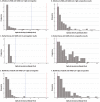Analytic comparison between three high-throughput commercial SARS-CoV-2 antibody assays reveals minor discrepancies in a high-incidence population
- PMID: 34088944
- PMCID: PMC8178338
- DOI: 10.1038/s41598-021-91235-x
Analytic comparison between three high-throughput commercial SARS-CoV-2 antibody assays reveals minor discrepancies in a high-incidence population
Abstract
Performance of three automated commercial serological IgG-based assays was investigated for assessing SARS-CoV-2 "ever" (past or current) infection in a population-based sample in a high exposure setting. PCR and serological testing was performed on 394 individuals. SARS-CoV-2-IgG seroprevalence was 42.9% (95% CI 38.1-47.8%), 40.6% (95% CI 35.9-45.5%), and 42.4% (95% CI 37.6-47.3%) using the CL-900i, VidasIII, and Elecsys assays, respectively. Between the three assays, overall, positive, and negative percent agreements ranged between 93.2-95.7%, 89.3-92.8%, and 93.8-97.8%, respectively; Cohen's kappa statistic ranged from 0.86 to 0.91; and 35 specimens (8.9%) showed discordant results. Among all individuals, 12.5% (95% CI 9.6-16.1%) had current infection, as assessed by PCR. Of these, only 34.7% (95% CI 22.9-48.7%) were seropositive by at least one assay. A total of 216 individuals (54.8%; 95% CI 49.9-59.7%) had evidence of ever infection using antibody testing and/or PCR during or prior to this study. Of these, only 78.2%, 74.1%, and 77.3% were seropositive in the CL-900i, VidasIII, and Elecsys assays, respectively. All three assays had comparable performance and excellent agreement, but missed at least 20% of individuals with past or current infection. Commercial antibody assays can substantially underestimate ever infection, more so when infection rates are high.
Conflict of interest statement
The authors declare no competing interests.
Figures


Similar articles
-
SARS-CoV-2 Antibody Testing in Health Care Workers: A Comparison of the Clinical Performance of Three Commercially Available Antibody Assays.Microbiol Spectr. 2021 Oct 31;9(2):e0039121. doi: 10.1128/Spectrum.00391-21. Epub 2021 Sep 29. Microbiol Spectr. 2021. PMID: 34585976 Free PMC article.
-
Head-to-head comparison of two rapid high-throughput automated electrochemiluminescence immunoassays targeting total antibodies to the SARS-CoV-2 nucleoprotein and spike protein receptor binding domain.J Clin Virol. 2021 Apr;137:104784. doi: 10.1016/j.jcv.2021.104784. Epub 2021 Mar 5. J Clin Virol. 2021. PMID: 33711693 Free PMC article.
-
Comparative evaluation of in-house ELISA and two commercial serological assays for the detection of antibodies against SARS-CoV-2.Sci Rep. 2025 Apr 22;15(1):13853. doi: 10.1038/s41598-025-97050-y. Sci Rep. 2025. PMID: 40263514 Free PMC article.
-
Comparison of the Clinical Performances of the Abbott Alinity IgG, Abbott Architect IgM, and Roche Elecsys Total SARS-CoV-2 Antibody Assays.J Clin Microbiol. 2020 Dec 17;59(1):e02104-20. doi: 10.1128/JCM.02104-20. Print 2020 Dec 17. J Clin Microbiol. 2020. PMID: 33106364 Free PMC article.
-
The reliability of SARS-CoV-2 IgG antibody testing - a pilot study in asymptomatic health care workers in a Croatian university hospital.Croat Med J. 2020 Dec 31;61(6):485-490. doi: 10.3325/cmj.2020.61.485. Croat Med J. 2020. PMID: 33410294 Free PMC article.
Cited by
-
Clinical evaluation of SARS-CoV-2 antigen-based rapid diagnostic test kit for detection of COVID-19 cases in Bangladesh.Heliyon. 2021 Nov;7(11):e08455. doi: 10.1016/j.heliyon.2021.e08455. Epub 2021 Nov 22. Heliyon. 2021. PMID: 34841119 Free PMC article.
-
A Highly Sensitive and Specific SARS-CoV-2 Spike- and Nucleoprotein-Based Fluorescent Multiplex Immunoassay (FMIA) to Measure IgG, IgA, and IgM Class Antibodies.Microbiol Spectr. 2021 Dec 22;9(3):e0113121. doi: 10.1128/Spectrum.01131-21. Epub 2021 Nov 17. Microbiol Spectr. 2021. PMID: 34787485 Free PMC article.
-
Antigenic properties of the SARS-CoV-2 nucleoprotein are altered by the RNA admixture.PeerJ. 2022 Jan 7;10:e12751. doi: 10.7717/peerj.12751. eCollection 2022. PeerJ. 2022. PMID: 35036106 Free PMC article.
-
Low Seroprevalence of SARS-CoV-2 among Healthcare Workers in Malaysia during the Third COVID-19 Wave: Prospective Study with Literature Survey on Infection Prevention and Control Measures.Healthcare (Basel). 2022 Sep 20;10(10):1810. doi: 10.3390/healthcare10101810. Healthcare (Basel). 2022. PMID: 36292257 Free PMC article.
-
Comparison of antibody immune responses between BNT162b2 and mRNA-1273 SARS-CoV-2 vaccines in naïve and previously infected individuals.J Travel Med. 2021 Dec 29;28(8):taab190. doi: 10.1093/jtm/taab190. J Travel Med. 2021. PMID: 34888670 Free PMC article.
References
-
- The World Health Organization . WHO Coronavirus Disease (COVID-19) Dashboard. WHO; 2020.
-
- The Roche Group. Roche’s COVID-19 antibody test receives FDA Emergency Use Authorization and is Available in Markets Accepting the CE Mark (2020). https://www.roche.com/media/releases/med-cor-2020-05-03.htm (Accessed 5 June 2020).
Publication types
MeSH terms
Substances
Grants and funding
LinkOut - more resources
Full Text Sources
Medical
Miscellaneous

